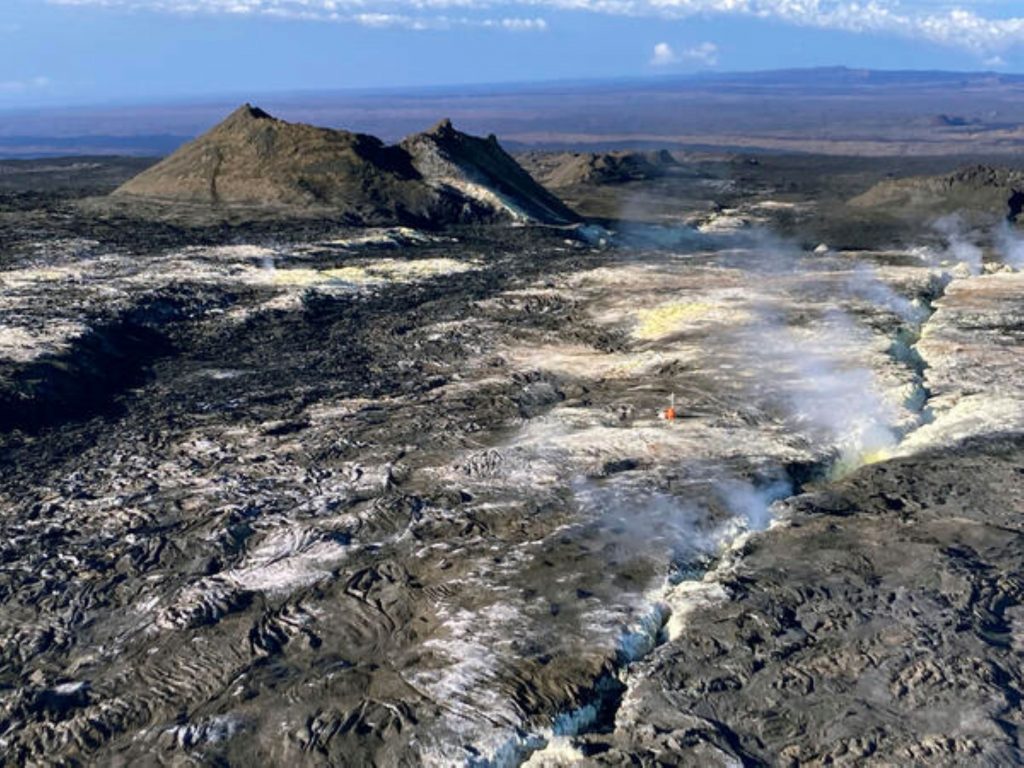Volcano Watch: ‘Your job sounds so cool! How does someone become a volcanologist?’
“Volcano Watch” is a weekly article and activity update written by U.S. Geological Survey Hawaiian Volcano Observatory scientists and affiliates.
What is a volcanologist, exactly? The short answer is a volcanologist is a person who studies volcanoes, but that’s not the whole story. There are as many different specialties within volcanology and as many paths you can take to get there as there are tools of the trade. What are these tools, you ask? Let’s have a look.

Earthquakes are one primary tool used to study volcanoes. A volcano seismologist studies the earthquakes that are generated as magma moves through the Earth’s crust. Another technique in the tool kit is measuring the change in a volcano’s shape. A volcano geodesist studies the deformation, or change in shape, of a volcano caused by the movement of magma and gases beneath the surface. Tools like these provide clues about the state of the volcano.
During an eruption, geologists and geochemists study the composition of lavas and gases to understand the source and style of the eruption. Measuring gas emissions is especially important, as the vog (volcanic air pollution) caused by toxic volcanic gases can contribute to breathing problems, acid rain and agricultural problems downwind, especially during long-lived eruptions. Many features of volcanoes can be studied from space, as well, using satellite sensors.
With so many techniques and specialties out there, you may be asking yourself, “How do I choose which path to follow? How do I choose which tool to use?” Don’t worry, it’s not necessary to pick a discipline right away. In fact, you shouldn’t.
The first thing to do is work toward a bachelor’s degree, preferably in a STEM (science, technology, engineering and math) field. Traditionally, volcanologists start out with degrees in geology, chemistry, physics or mathematics, but that is not always the case. Oceanography, computer science, engineering, environmental science are all potential pathways, and the list goes on. Explore different fields to your heart’s desire. There’s no one way to get to volcanology.
Sadly, gone are the days when one could apply to a volcano observatory right after undergraduate studies and hope to learn on the job. To study volcanoes, it is typically necessary to get a masters or doctorate degree. The good news is many advanced degree programs in the sciences are fully funded, meaning tuition is waived, and they typically provide a stipend. Basically, you get paid instead of having to pay the school. This is where a budding volcanologist starts to choose their specialty. Of course, working through 4 to 8 years of a PhD after already spending four or more years getting a bachelor’s degree isn’t for everyone. While research institutes such as universities and volcano observatories require advanced degrees, there are other pathways available for those who love volcanoes and Earth science but do not have a higher degree.
The National Park Service offers a variety of positions for people with either bachelor’s or advanced degrees, such as park geologists, archaeologists, botanists, guides, interpretive rangers and law enforcement rangers. Science writing and journalism are also excellent ways to explore the excitement of volcanology, natural disasters and cutting-edge science while encouraging those passions in others. Similarly, eco- and geo-tourism are great ways to get close to the action and work outdoors, while also meeting, educating and inspiring people from all over the world.
The candid truth about careers in volcanology and earth science is that they are a labor of love. Volcanology is not the career for those whose priorities are a six-figure salary, a healthy work-life balance and early retirement. What it lacks in pay, however, is made up in adventure and a deep sense of purpose.
International travel and collaboration, creative scientific research and the knowledge that this work may save lives are the raisons d’être for volcanologists. Collecting unbelievable stories to tell the grandkids is, of course, a bonus. Once a person bears witness to the raw power and beauty of our planet — watching volcanoes erupt firsthand and the new growth that follows — it sticks with them for life. For many volcanologists, it is difficult to imagine doing anything else.
Volcano Activity Updates
Mauna Loa is not erupting. Its USGS Volcano Alert Level is at ADVISORY. Mauna Loa updates are issued weekly on Thursdays.
Webcam imagery shows weak, residual incandescence intermittently in the inactive Northeast Rift Zone fissure 3 lava flow at night. Seismicity remains low and ground deformation rates have decreased. Sulfur dioxide (SO2) emission rates are at background levels. For Mauna Loa monitoring data, see https://www.usgs.gov/volcanoes/mauna-loa/monitoring-data.
Kīlauea is not erupting. Its USGS Volcano Alert level is at ADVISORY. Kīlauea updates are issued weekly on Tuesdays.
Lava supply to the Halemaʻumaʻu lava lake in Hawai‘i Volcanoes National Park ceased on Dec. 9. Sulfur dioxide emission rates have decreased to near pre-eruption background levels and were last measured at approximately 200 tonnes per day (t/d) on Dec. 14. Seismicity is elevated but stable, with few earthquakes. Over the past week, summit tiltmeters recorded several deflation-inflation (DI) events. For Kīlauea monitoring data, see https://www.usgs.gov/volcanoes/kilauea/past-week-monitoring-data-kilauea.
There were three earthquakes with 3 or more felt reports in the Hawaiian Islands during the past week: a M3.3 earthquake 14 km (8 mi) S of Fern Forest at 7 km (4 mi) depth on Dec. 27 at 4:33 a.m. HST, a M3.4 earthquake 7 km (4 mi) WSW of Volcano at 2 km (1 mi) depth on Dec. 24 at 8:31 p.m. HST, and a M2.5 earthquake 1 km (0 mi) S of Mountain View at 11 km (7 mi) depth on Dec. 24 at 9:57 a.m. HST.
HVO continues to closely monitor the ongoing eruptions at Kīlauea and Mauna Loa.
Visit HVO’s website for past “Volcano Watch” articles, Kīlauea and Mauna Loa updates, volcano photos, maps, recent earthquake info and more. Email questions to askHVO@usgs.gov.
Sponsored Content
Comments








